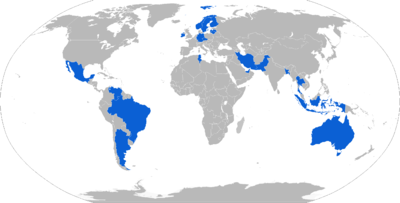RBS 70
| RBS 70 | |
|---|---|
|
RBS 70 training simulator | |
| Type |
Short-range Air Defense (SHORAD) Man-portable air-defence system (MANPADS) |
| Place of origin | Sweden |
| Service history | |
| In service | 1977–present |
| Production history | |
| Manufacturer |
Bofors Defence (1980s–2000) Saab Bofors Dynamics (since 2000) |
| Specifications | |
| Weight | 87 kg (Stand + Sight + Missile) |
| Length | 1.32 m |
| Diameter | 106 mm |
| Warhead | 1.1 kg Combined with 3,000 tungsten spheres and shaped charge |
Detonation mechanism | Adaptive proximity fuze function with 3 selectable modes (Off, Normal, Small target) |
|
| |
| Engine | Booster and sustainer with smokeless solid propellant |
| Wingspan | 32 cm |
Operational range | 250 m–8 km |
| Flight altitude | 5,000 m |
| Speed |
Mach 1.6 (Mark 0/1) Mach 2 (5 km in 12 seconds) (Mark 2/BOLIDE) |
Guidance system | Laser beam riding missile |
Launch platform | tripod, weapon platform (ASRAD-R) and warship |
RBS 70 (Robotsystem 70, "robot" meaning "missile" in this context in Swedish) is a man-portable air-defense system (MANPADS) designed for anti-aircraft warfare in all climate zones and with little to no support from other forces. Originally designed and manufactured by the Swedish defence firm of Bofors Defence (now Saab Bofors Dynamics, since 2000). It uses the RB 70 missile which is also in use in a number of other Swedish missile systems.
History
The RBS 70 was developed to supply the Swedish air defense with a low-cost, easy-to-use and effective short-range SAM system. Before RBS 70 the mainstay of Swedish air defense was American MIM-23 Hawk systems (RBS 77 and RBS 97 "Swedish HAWK"), American Redeye (RBS 69) and the Swedish Bofors m/48 AAA.
The Swedish Army has decided to replace the RBS 70 with a ground-launched version of the IRIS-T missile.[1]
Design

The RBS 70 is a Short-range Air Defense (SHORAD) laser guided missile system.
Mk 1 and Mk 2 followed shortly and are the standard RBS 70 with a range of 5,000–6,000 m and a ceiling of 3,000 m. Currently, RBS 70 is operational in 18 customer countries, on all continents and in arctic, desert, and tropical environments.
In 2003 the "BOLIDE" upgrade system was introduced to the RBS 70.[2] The BOLIDE missile is an RBS 70 Mk 2 upgrade that is faster (Mach 2 vs Mach 1.6), with a range up to 8 km (5.0 mi) and can reach an altitude of 5 km. Deliveries were initiated in 2005.
Latest upgrade
In 2011, Saab Bofors Dynamics (successor company of Bofors Defence) announced the introduction of the new RBS 70 New Generation (RBS 70 NG). The upgraded version included an improved sighting system capable of night vision and improved training and after-action review features.[3]
Operational use
In 1992, a Venezuelan Army RBS-70 SAM is attributed with having shot down a rebel OV-10 Bronco during the 1992 Venezuelan coup d'état attempt on November 27.[4]
Operators

Current operators
-
 Argentina[5]
Argentina[5] -
 Australia
Australia -
 Bahrain
Bahrain -
 Brazil[6]
Brazil[6] -
 Chile
Chile -
 Czech Republic[7]
Czech Republic[7] -
 Finland[8]
Finland[8] -
 Indonesia
Indonesia -
 Iran
Iran -
 Ireland
Ireland -
 Latvia
Latvia -
 Lithuania[9]
Lithuania[9] -
 Mexican Army
Mexican Army -
 Norway (no longer in active service)
Norway (no longer in active service) -
 Pakistan: 144 in service with the Pakistan Army.[10]
Pakistan: 144 in service with the Pakistan Army.[10] -
 Singapore
Singapore -
 Sweden
Sweden  Thailand
Thailand Tunisia
Tunisia United Arab Emirates
United Arab Emirates Venezuela
Venezuela
See also
- Luftvärnsrobotvagn 701 (Lvrbv 701), a self-propelled vehicle mounted version of RBS 70
- ASRAD-R (Advanced Short Range Air Defence System – RBS)
- SA-18 Grouse (Igla) Surface-to-Air Missile
- Starstreak Surface-to Air Missile
- FIM-92 Stinger Surface-to-Air Missile
- Mistral Surface-to-Air Missile
- List of missiles
- Starburst (missile)
References
- Citations
- ↑ "More Air Launched Missiles Go To Ground", Strategy page, January 26, 2013.
- ↑ "RBS 70 NG VSHORAD: BACKGROUND: INNOVATION IT'S IN OUR BLOOD". Saab Bofors Dynamics. 2010. Retrieved 28 September 2011.
- ↑ "RBS 70 NG VSHORAD: NEW GENERATION". Saab Bofors Dynamics. 2010. Retrieved 28 September 2011.
- ↑ "Chronological Listing of Venezuelan Losses & Ejections". Project Get Out and Walk.
- ↑ The World Defence Almanac, 1996–97, p. 38, ISSN 0722-3226.
- ↑ "Army of Brazil to purchase SAAB RBS 70 VSHORAD Very Short Range Air Defense System". Army recognition. March 4, 2014.
- ↑ "Register of the transfers of major conventional weapons from Sweden 1995–2005" (PDF). Stockholm International Peace Research Institute (SIPRI).
- ↑ Saab sells air defence to Finland worth 600 million SEK (press release), Saab, 2007-01-18.
- ↑ "Giddy over air-defense system". The Baltic Times. Baltic News Service. November 17, 2004.
- ↑ Hussain, Maryam (June 2, 2006). "Deal signed with Bofors for missile repair". The Daily Times (Pakistan). Retrieved May 26, 2013.
External links
| Wikimedia Commons has media related to RBS-70. |
- Official SAAB company page of RBS 70
- Bofors RBS 70 at the Federation of American Scientists (FAS) website
- RBS 70 at GlobalSecurity.org
- RBS 70 NG VSHORAD Very Short Range Air Defense Missile System at armyrecognition.com
